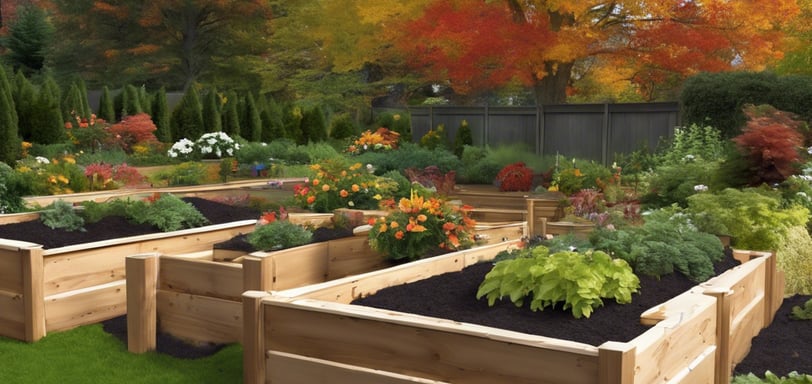"10 Essential Fall Gardening Tasks to Prepare for Winter"
Discover how to get your garden ready for the colder months with these 10 essential fall tasks. From cleaning up garden beds and planting spring bulbs to mulching and protecting young plants, this guide will help you prepare your garden for a healthy, vibrant start next spring. Perfect for gardeners of all levels, these tips ensure your hard work pays off year-round!
GARDEN & RECIPES
Jennifer Miller
11/20/20243 min read


10 Essential Fall Garden Tasks to Prepare for Winter
As the crisp fall air sets in and the vibrant colors of summer fade, it’s the perfect time to prepare your garden for the colder months ahead. Fall is more than just a time to admire the changing leaves—it's also an opportunity to set your garden up for success in the spring. From cleaning up to planting for the future, these fall tasks will ensure your garden weathers the winter beautifully.
Tidy Up Garden Beds for a Fresh Start
One of the most important fall chores is cleaning up your garden beds. Removing spent plants and trimming back perennials helps prevent pests and diseases from overwintering in your garden. Decaying plants can harbor fungi and harmful insects, so pulling out annuals and cutting back dead foliage is key. As you tidy up, consider composting healthy plant material to recycle those nutrients for future use.
Turn Fallen Leaves into Garden Gold
Instead of bagging up your fallen leaves, put them to good use! Shredded leaves make an excellent addition to your compost, providing essential carbon for decomposition. If you’re looking for a simple way to improve your soil, create leaf mold by storing shredded leaves in a moist pile or bag for a year. This rich, crumbly material will work wonders for your garden beds next spring.
Plant Spring Bulbs for a Burst of Color
Fall is the perfect time to plant bulbs like tulips, daffodils, and crocuses. These hardy beauties need the cooler temperatures of winter to bloom in spring. Dig holes two to three times the height of the bulb, pointy side up, and cover with soil. Adding a little bone meal or bulb fertilizer to the hole gives them a boost for healthy growth. When snow melts, you'll be rewarded with vibrant flowers bursting through the ground.
Mulch to Protect and Nourish
A layer of mulch in the fall does wonders for your garden. It insulates plant roots, prevents soil erosion, and suppresses weeds during the colder months. Spread a 2-4 inch layer of organic mulch, like straw, shredded leaves, or wood chips, around your plants. Be careful not to pile it directly against stems or trunks to avoid rot. For an added bonus, use composted mulch to give your soil a nutrient boost.
Prune Trees and Shrubs for Winter Health
Pruning trees and shrubs in the fall helps them stay healthy and maintain their shape. Removing dead or diseased branches now prevents problems from spreading during winter. Use clean, sharp pruning shears and make cuts just above a healthy bud or branch junction. Be cautious with spring-flowering shrubs—pruning them in fall can reduce blooms. Save their trim for after they flower in spring.
Divide and Transplant Perennials
If your perennials are looking overcrowded, fall is the time to divide them. Dividing perennials promotes healthier plants and gives you the chance to spread them throughout your garden—or share them with friends! Dig up the plant, divide it into smaller clumps, and replant the sections at the same depth they were growing. Water well and add a layer of mulch to help them settle in.
Prep Vegetable Beds for Next Season
As the growing season winds down, give your vegetable beds some love. Remove leftover plants and weeds, then add a layer of compost or manure to enrich the soil. Covering the beds with mulch or a winter cover crop like clover or winter rye protects the soil and prevents erosion. Bonus: cover crops also add nutrients to the soil when tilled under in spring.
Winterize Your Lawn
Your lawn deserves some attention in fall too! Aerating compacted soil, applying a potassium-rich fall fertilizer, and reseeding bare patches will give your grass the strength it needs to survive winter. Keep mowing until growth stops, but leave your lawn at a healthy height of 2-3 inches to prevent matting under snow.
Protect Young Trees and Shrubs
Winter winds and hungry wildlife can be tough on young trees and shrubs. Wrapping trunks with tree guards or burlap prevents damage from the elements and critters. Mulching around the base insulates roots, and creating a burlap wind barrier can offer extra protection for particularly vulnerable plants.
Clean and Store Your Tools
Before you hang up your gardening gloves for the season, don’t forget to clean and store your tools. Wash off dirt, dry them thoroughly, and apply a light coat of oil to prevent rust. Sharpening blades now will save you time in spring. Storing tools in a dry, covered location—and hanging them when possible—ensures they’ll be in great shape when the next growing season begins.
Closing Thoughts
Fall gardening isn’t just about wrapping things up for the year—it’s about setting the stage for a vibrant spring. Whether you’re composting leaves, planting bulbs, or protecting young plants, each task you complete will make a big difference come warmer weather. Embrace the season’s slower pace and enjoy the process of putting your garden to bed. After all, every great garden starts with a little preparation.

